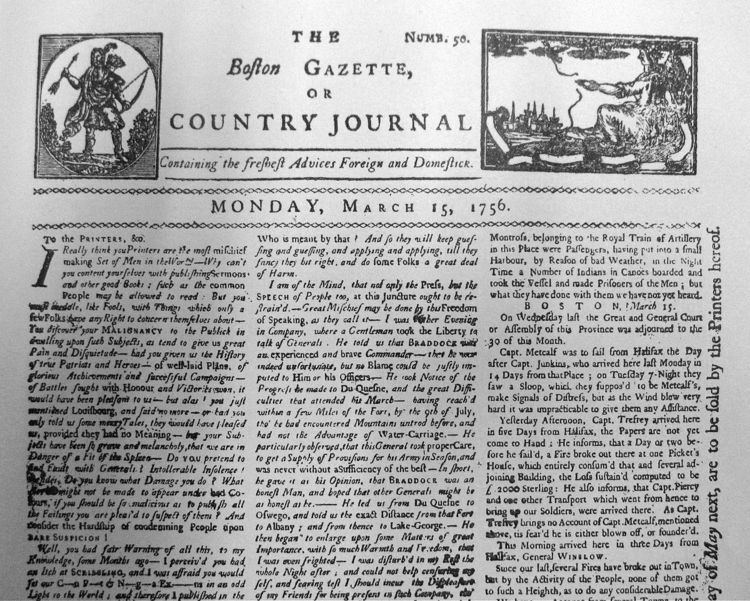Type Weekly newspaper Language English | Founded 1719 Ceased publication 1798 | |
 | ||
Headquarters Boston, Massachusetts United States | ||
The Boston Gazette (1719–1798) was a newspaper published in Boston, Massachusetts, in the British North American colonies. It began publication December 21, 1719 and appeared weekly. It should not be confused with the Boston gazette (1803–16).
The Boston Gazette (published by Benjamin Edes and John Gill) was probably the most influential newspaper ever in American history.
It essentially started the American Revolution. For years before the first shots were fired at Lexington Green, Samuel Adams, Joseph Warren, Josiah Quincy, James Otis, Edes and Gill were writing article after article in the Boston Gazette, rebelling against royal authority. Adams wrote so many articles, under so many pen names (at least 25), historians don't even know exactly how many he wrote. It was the Boston Gazette that hired Paul Revere to create his famous engraving of the Boston Massacre.
The British officials hated the Boston Gazette. British officers placed the paper's name on a list of enemy institutions to be captured, and if possible, laid waste. Those trumpeters of sedition, Edes and Gill, were to be put out of business once and for all.
The Sons of Liberty met at the Boston Gazette. It was there that they darkened their faces, disguising themselves as Mohawk Indians before setting out to dump British tea into Boston Harbor at the Boston Tea Party. Sam Adams practically lived at the Boston Gazette.
The Boston News-Letter, the first successful newspaper in the Colonies, which had begun its long run in 1704. In 1741 the Boston Gazette incorporated the New-England Weekly Journal and became the Boston-Gazette, or New-England Weekly Journal. Contributors included: Samuel Adams, Paul Revere, Phyllis Wheatley.
Publishers, and men acting their behalf, included: (dates are approximate)
The paper's masthead vignette, produced by Paul Revere shows a seated Britannia with Liberty cap on staff, freeing a bird from a cage. Motto: "Containing the freshest Advices, Foreign and Domestic" This issue is often reprinted.
"After the Revolution [the paper] lost its great contributors and its tone and policy were changed. It bitterly opposed the adoption of the constitution of the United States and the administration of Washington. The paper declined in power, interest and popular favor, till, after a long struggle, in 1798, it was discontinued for want of support."
Varying Titles
In recent years, the Boston Gazette print shop of Edes & Gill has been recreated and is open to the public as a museum in Boston.
